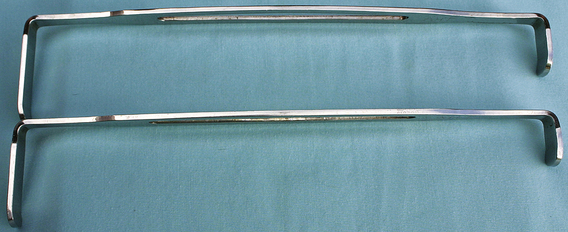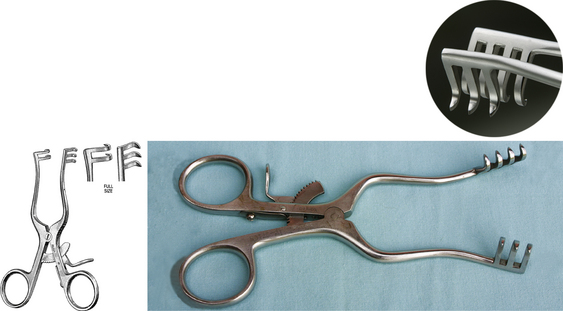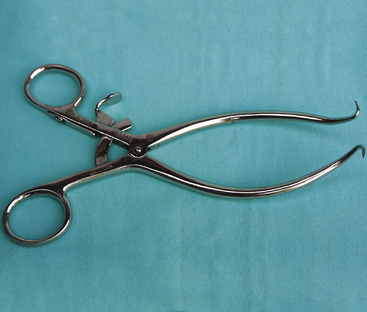CHAPTER 18 Retractors and Rib Spreaders
Retractors are instruments that are used to hold open a wound, incision, or organs so that the surgeon can view underlying tissues. Retractors are either hand held or self-retaining. Rib spreaders hold the ribs apart, allowing access to the thoracic cavity.
Hand-Held Retractors
INSTRUMENT
U.S. Army–Pattern Retractor
| FUNCTION | To hold open a wound or incision so that the surgeon can view underlying tissues. |
| COMMON NAME | Army Retractor |
| CHARACTERISTICS | This retractor comes in a set of two. It is a double-ended retractor with a lateral curve of the blades on each end. One end is a curved paddle about ⅝ inch wide and is placed over the wound edges to ease the wound open gently. The other end is angled and has longer ends to facilitate a good grip with the fingers or to go deeper into a wound cavity. The length of the retractor is 8½ inches. |
INSTRUMENT
Senn Rake Retractor
| FUNCTION | To hold open a wound or incision so that the surgeon can view the underlying tissues. |
| COMMON NAME | Senns |
| CHARACTERISTICS | This retractor is about 6¼ inches long and ends in three-pronged sharp or blunt points that curve sharply. It works well with smaller incisions and wounds than the U.S. Army–pattern retractor. Small handles allow only one or two fingers to hold the instrument. |
Self-Retaining Retractors
INSTRUMENT
Weitlaner Retractor
| FUNCTION | To maintain muscle retraction during orthopedic surgery. |
| CHARACTERISTICS | Sharp or blunt, outward-curved prongs are held open by a ratchet just above the handle. The prongs come in a 3 × 4 configuration. Lengths are 4, 5½, 6½, 8, and 9½ inches. The 4-inch retractor is referred to as a “baby Weitlaner”; its prongs are 2 × 3. |
< div class='tao-gold-member'>
Only gold members can continue reading. Log In or Register to continue
Stay updated, free articles. Join our Telegram channel

Full access? Get Clinical Tree






